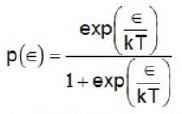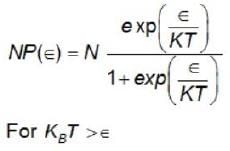GATE Exam > GATE Questions > Consider 1000 non - interacting , distinguish...
Start Learning for Free
Consider 1000 non - interacting , distinguishable particles in a two-level system at temp T. The energies of the levels are 0 and ε, whwere ∈> 0. In the high temperature limit (KBT > ε). What is the population of particles in the level with energy ε.
Correct answer is '500'. Can you explain this answer?
| FREE This question is part of | Download PDF Attempt this Test |
Verified Answer
Consider 1000 non - interacting , distinguishable particles in a two-l...
let the total No. of non-interacting distinguishable particles are N

Population of particle in the level with energy ∈ is


So, the population of particles is the level with energy ∈ is 500.

Population of particle in the level with energy ∈ is


So, the population of particles is the level with energy ∈ is 500.
Most Upvoted Answer
Consider 1000 non - interacting , distinguishable particles in a two-l...
The two-level system can be thought of as a collection of N = 1000 independent two-level systems, each with an energy gap of ΔE = ɛ. The partition function for a single two-level system is given by:
Z = e^(-ɛ/kT) + e^(0/kT) = 1 + e^(-ɛ/kT)
The total partition function for N independent two-level systems is simply the product of the individual partition functions:
Z_total = Z^N = (1 + e^(-ɛ/kT))^N
The average energy of the system is given by the formula:
⟨E⟩ = - ∂ ln Z_total / ∂ β
where β = 1/kT is the inverse temperature. Taking the derivative and using the chain rule, we get:
⟨E⟩ = - Nɛ e^(-ɛ/kT) / (1 + e^(-ɛ/kT))
The specific heat at constant volume is given by:
C_V = (∂ ⟨E⟩ / ∂ T)_V = (kNɛ^2 / kT^2) e^(-ɛ/kT) / (1 + e^(-ɛ/kT))^2
At high temperatures (kT >> ɛ), we can use the approximation e^(-ɛ/kT) < 1="" to="" simplify="" the="" expressions.="" in="" this="" limit,="" we="" />
Z_total ≈ e^N
⟨E⟩ ≈ - Nɛ / (1 + e^(ɛ/kT))
C_V ≈ kN
This is the classical limit, where the particles are treated as distinguishable and the energy levels are well defined. At low temperatures (kT < ɛ),="" we="" />
Z_total ≈ (1 + e^(-ɛ/kT))^N
⟨E⟩ ≈ - Nɛ e^(-ɛ/kT) / 2
C_V ≈ (kNɛ^2 / kT^2) e^(-ɛ/kT) / 4
This is the quantum limit, where the particles are treated as indistinguishable and the energy levels are broadened by thermal fluctuations. The specific heat is suppressed at low temperatures due to the Pauli exclusion principle.
Z = e^(-ɛ/kT) + e^(0/kT) = 1 + e^(-ɛ/kT)
The total partition function for N independent two-level systems is simply the product of the individual partition functions:
Z_total = Z^N = (1 + e^(-ɛ/kT))^N
The average energy of the system is given by the formula:
⟨E⟩ = - ∂ ln Z_total / ∂ β
where β = 1/kT is the inverse temperature. Taking the derivative and using the chain rule, we get:
⟨E⟩ = - Nɛ e^(-ɛ/kT) / (1 + e^(-ɛ/kT))
The specific heat at constant volume is given by:
C_V = (∂ ⟨E⟩ / ∂ T)_V = (kNɛ^2 / kT^2) e^(-ɛ/kT) / (1 + e^(-ɛ/kT))^2
At high temperatures (kT >> ɛ), we can use the approximation e^(-ɛ/kT) < 1="" to="" simplify="" the="" expressions.="" in="" this="" limit,="" we="" />
Z_total ≈ e^N
⟨E⟩ ≈ - Nɛ / (1 + e^(ɛ/kT))
C_V ≈ kN
This is the classical limit, where the particles are treated as distinguishable and the energy levels are well defined. At low temperatures (kT < ɛ),="" we="" />
Z_total ≈ (1 + e^(-ɛ/kT))^N
⟨E⟩ ≈ - Nɛ e^(-ɛ/kT) / 2
C_V ≈ (kNɛ^2 / kT^2) e^(-ɛ/kT) / 4
This is the quantum limit, where the particles are treated as indistinguishable and the energy levels are broadened by thermal fluctuations. The specific heat is suppressed at low temperatures due to the Pauli exclusion principle.

|
Explore Courses for GATE exam
|

|
Similar GATE Doubts
Consider 1000 non - interacting , distinguishable particles in a two-level system at temp T. The energies of the levels are 0 and ε, whwere ∈> 0. In the high temperature limit (KBT > ε). What is the population of particles in the level with energy ε.Correct answer is '500'. Can you explain this answer?
Question Description
Consider 1000 non - interacting , distinguishable particles in a two-level system at temp T. The energies of the levels are 0 and ε, whwere ∈> 0. In the high temperature limit (KBT > ε). What is the population of particles in the level with energy ε.Correct answer is '500'. Can you explain this answer? for GATE 2024 is part of GATE preparation. The Question and answers have been prepared according to the GATE exam syllabus. Information about Consider 1000 non - interacting , distinguishable particles in a two-level system at temp T. The energies of the levels are 0 and ε, whwere ∈> 0. In the high temperature limit (KBT > ε). What is the population of particles in the level with energy ε.Correct answer is '500'. Can you explain this answer? covers all topics & solutions for GATE 2024 Exam. Find important definitions, questions, meanings, examples, exercises and tests below for Consider 1000 non - interacting , distinguishable particles in a two-level system at temp T. The energies of the levels are 0 and ε, whwere ∈> 0. In the high temperature limit (KBT > ε). What is the population of particles in the level with energy ε.Correct answer is '500'. Can you explain this answer?.
Consider 1000 non - interacting , distinguishable particles in a two-level system at temp T. The energies of the levels are 0 and ε, whwere ∈> 0. In the high temperature limit (KBT > ε). What is the population of particles in the level with energy ε.Correct answer is '500'. Can you explain this answer? for GATE 2024 is part of GATE preparation. The Question and answers have been prepared according to the GATE exam syllabus. Information about Consider 1000 non - interacting , distinguishable particles in a two-level system at temp T. The energies of the levels are 0 and ε, whwere ∈> 0. In the high temperature limit (KBT > ε). What is the population of particles in the level with energy ε.Correct answer is '500'. Can you explain this answer? covers all topics & solutions for GATE 2024 Exam. Find important definitions, questions, meanings, examples, exercises and tests below for Consider 1000 non - interacting , distinguishable particles in a two-level system at temp T. The energies of the levels are 0 and ε, whwere ∈> 0. In the high temperature limit (KBT > ε). What is the population of particles in the level with energy ε.Correct answer is '500'. Can you explain this answer?.
Solutions for Consider 1000 non - interacting , distinguishable particles in a two-level system at temp T. The energies of the levels are 0 and ε, whwere ∈> 0. In the high temperature limit (KBT > ε). What is the population of particles in the level with energy ε.Correct answer is '500'. Can you explain this answer? in English & in Hindi are available as part of our courses for GATE.
Download more important topics, notes, lectures and mock test series for GATE Exam by signing up for free.
Here you can find the meaning of Consider 1000 non - interacting , distinguishable particles in a two-level system at temp T. The energies of the levels are 0 and ε, whwere ∈> 0. In the high temperature limit (KBT > ε). What is the population of particles in the level with energy ε.Correct answer is '500'. Can you explain this answer? defined & explained in the simplest way possible. Besides giving the explanation of
Consider 1000 non - interacting , distinguishable particles in a two-level system at temp T. The energies of the levels are 0 and ε, whwere ∈> 0. In the high temperature limit (KBT > ε). What is the population of particles in the level with energy ε.Correct answer is '500'. Can you explain this answer?, a detailed solution for Consider 1000 non - interacting , distinguishable particles in a two-level system at temp T. The energies of the levels are 0 and ε, whwere ∈> 0. In the high temperature limit (KBT > ε). What is the population of particles in the level with energy ε.Correct answer is '500'. Can you explain this answer? has been provided alongside types of Consider 1000 non - interacting , distinguishable particles in a two-level system at temp T. The energies of the levels are 0 and ε, whwere ∈> 0. In the high temperature limit (KBT > ε). What is the population of particles in the level with energy ε.Correct answer is '500'. Can you explain this answer? theory, EduRev gives you an
ample number of questions to practice Consider 1000 non - interacting , distinguishable particles in a two-level system at temp T. The energies of the levels are 0 and ε, whwere ∈> 0. In the high temperature limit (KBT > ε). What is the population of particles in the level with energy ε.Correct answer is '500'. Can you explain this answer? tests, examples and also practice GATE tests.

|
Explore Courses for GATE exam
|

|
Suggested Free Tests
Signup for Free!
Signup to see your scores go up within 7 days! Learn & Practice with 1000+ FREE Notes, Videos & Tests.


















